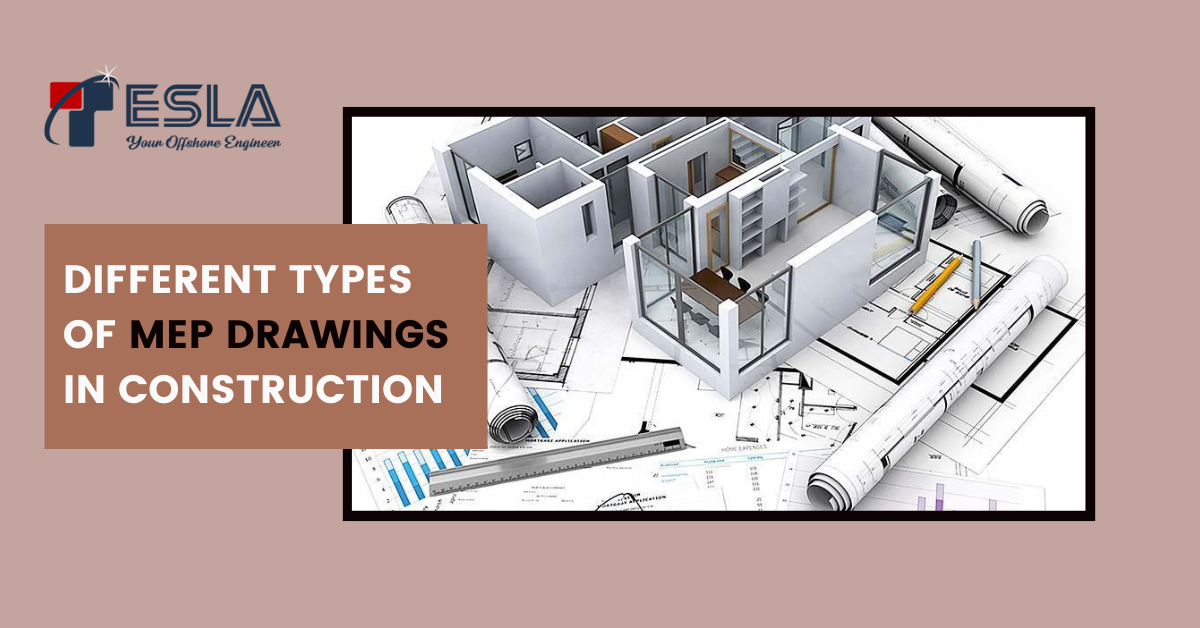Introduction
In modern construction, MEP systems are essential for functionality and occupant comfort. As construction methods advance, detailed MEP drawings are crucial. Building Information Modeling (BIM) technology revolutionizes MEP drawings, ensuring precision and efficiency. MEP systems are vital for climate control, power distribution, and water supply, requiring careful planning and coordination. Accurate MEP drawings are indispensable amid complex projects. Security considerations emphasize the need for robust MEP systems, safeguarding occupants and assets. This article explores MEP drawing types, their importance, and benefits. By highlighting the role of MEP BIM services, we empower construction professionals to optimize building performance and security.
Types of MEP Drawings
The diverse array of MEP drawings serves as the cornerstone of building design, facilitating the seamless integration of essential systems and technologies. By embracing MEP BIM Services, construction professionals can unlock new possibilities in MEP coordination, optimization, and performance, ultimately delivering safer, smarter, and more sustainable buildings.
- Mechanical Drawings: Mechanical drawings are integral components of building design, encompassing HVAC systems, ductwork layouts, and equipment configurations. HVAC systems regulate indoor air quality, temperature, and humidity levels, ensuring occupant comfort and productivity. Within mechanical drawings, detailed schematics depict the placement of heating and cooling units, air distribution ducts, and ventilation shafts. Utilizing BIM technology, mechanical drawings transition from traditional 2D representations to dynamic 3D models, facilitating comprehensive visualization and analysis.
- Electrical Drawings: Electrical drawings elucidate the intricacies of power distribution, lighting arrangements, and wiring layouts within buildings. These drawings delineate the positioning of electrical panels, outlets, switches, and lighting fixtures, ensuring seamless integration and optimal functionality. By leveraging BIM, electrical drawings undergo a paradigm shift towards enhanced accuracy and efficiency. Through detailed modeling, cable routing simulations, and voltage drop analyses, BIM empowers designers to optimize electrical systems for maximum performance and energy efficiency.
- Plumbing Drawings: Plumbing drawings outline the layout of piping networks, drainage systems, and water supply infrastructure within buildings. From sanitary fixtures to water distribution pipes, plumbing drawings provide comprehensive guidance for installation and maintenance. With BIM-enabled plumbing drawings, designers can visualize complex piping configurations in 3D, identify potential clashes with structural elements, and streamline pipe sizing calculations. By incorporating real-time data and simulations, BIM enhances the reliability and resilience of plumbing systems, minimizing the risk of leaks, blockages, and inefficiencies.
Uses of MEP Drawings:
MEP drawings serve multifaceted purposes throughout the lifecycle of a construction project, encompassing design, coordination, construction, and facility management stages. These drawings are indispensable tools for architects, engineers, contractors, and facility managers, enabling them to visualize, analyze, and execute MEP systems with precision and efficiency.
- Design and Coordination: During the design phase, MEP drawings provide a comprehensive framework for conceptualizing and refining mechanical, electrical, and plumbing systems. Designers utilize these drawings to establish spatial requirements, identify equipment locations, and ensure compliance with regulatory standards and project specifications. Through BIM-enabled collaboration platforms, stakeholders can seamlessly exchange information, resolve conflicts, and iteratively refine design solutions, fostering a collaborative and integrated approach to MEP coordination.
- Clash Detection and Resolution: MEP drawings play a pivotal role in clash detection and resolution, mitigating conflicts and inconsistencies that may arise during the construction process. By overlaying MEP drawings with architectural and structural models, designers can identify spatial conflicts, collision points, and clearance issues in real-time. Leveraging BIM software, automated clash detection algorithms highlight potential clashes, enabling prompt resolution through design modifications or coordination meetings. By preemptively addressing clashes, construction delays, rework, and cost overruns are minimized, enhancing project efficiency and profitability.
- Cost Estimation and Procurement: MEP drawings serve as a basis for estimating material quantities, labor requirements, and project costs, facilitating accurate budgeting and procurement decisions. Contractors utilize these drawings to generate bill of materials (BOM), quantify resource requirements, and solicit competitive bids from suppliers and subcontractors. With BIM-enabled quantity takeoff tools, estimators can extract precise measurements from digital models, minimizing errors and discrepancies in cost estimation. By aligning project budgets with MEP drawings, stakeholders can optimize resource allocation, mitigate financial risks, and enhance project profitability.
- Facility Management and Maintenance Planning: Following construction completion, MEP drawings transition into valuable assets for facility management and maintenance operations. Facility managers leverage these drawings to locate equipment, access service records, and plan routine maintenance tasks. By integrating MEP drawings with computerized maintenance management systems, facilities teams can streamline work order management, track asset performance, and optimize equipment lifecycle. Additionally, BIM-enabled digital twins enable predictive maintenance strategies, leveraging real-time sensor data and analytics to anticipate equipment failures and optimize maintenance schedules.
Conclusion:
In conclusion, MEP drawings play a pivotal role in shaping the built environment, facilitating the seamless integration of mechanical, electrical, and plumbing systems within buildings. From design and coordination to construction and facility management, MEP drawings serve as indispensable tools for optimizing project outcomes and enhancing building performance. By embracing BIM Services, construction professionals can harness the full potential of MEP drawings, fostering collaboration, efficiency, and innovation throughout the construction lifecycle. As the construction industry continues to evolve, the adoption of MEP BIM services will undoubtedly emerge as a catalyst for delivering safer, smarter, and more sustainable buildings that meet the evolving needs of modern society.

